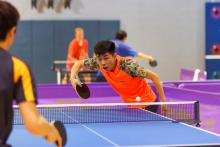What is the main difference between 2200 players and 2600 players? I haven’t read the table tennis forums for many years. However, one of my friends recently told me about a popular topic where many players were trying to figure out the main characteristic or main difference between a 2200 rated player and 2600 rated player. This same question can be asked of 1800 vs 2200 players or 2300 vs 2700 players. Is the main difference fitness? Anticipation? Reflexes? Talent? Number of hours on the table? Equipment? Muscle mass? Training routine? Game tactics?
According to my friend, the most popular assumption was anticipation. Most players thought that 2600 players anticipate better than 2200 players.
Yes and No
Yes they anticipate better, but why?
Why do 2600 rated players anticipate better than 2200 players.
BECAUSE OF THEIR BALL QUALITY!
Ball quality is the answer. A 2600 level serve is extremely difficult to read. Even if you read it, what can you really do with it? It is typically very low and difficult to make a strong flip. The short serve is usually fast enough that it is difficult to drop shot. The long serve is usually a surprise and so fast and so well placed that it can’t be easily managed. That’s just the serve. What about their returns? Basically, the 2600 player has the ability to attack all serves. And not just attack all serves, but to use various types of flips and loops to awkward locations forcing you to immediately block. When a 2600 player does a power loop, it is usually very spinny, very low, very deep, very well placed, while still being very consistent. On top of all that, the 2600 player is so balanced that he can easily recover and fire off multiple loops from any position on the table to any location on the table. Even when the 2600 player is blocking, usually the block is quick, low, with some pressure.
The ball quality on serving, receiving, pushing, flipping, blocking, looping, and counterlooping is so much better than the 2200 player that YES, absolutely, the 2600 player can anticipate better. He can anticipate better because he knows the limitation of his opponent based on his ball quality. Let me give you two illustration…
Illustration #1
The 2600 rated player serves very very heavy backspin half-long, where the second bounce is just touching the white line. What can his 2200-rated opponent do? He can’t loop it, he can’t push it short, he can’t flip it, so Mr. 2200 pushes it long. How did the 2600-rated player KNOW that a long push was coming??? He knew with 95% certainty that a long push was coming because of his ball quality.
Illustration #2
The 2600 rated player is looping with his forehand to his opponent’s wide backhand. How does he know that his opponent will block? The 2600 player’s forehand is so low and spinny and wide, that the 2200 player must block with his backhand. The ball is too wide to step around. The ball is too spinny to counterloop. The ball is too low to smash. The 2600-rated player KNEW that a controlled backhand block was coming because of his ball quality.
There many aspects to developing ball quality. Here are a few very quick tips:
A. Positioning – learn to move your feet into the proper position based on your hit, your opponent’s racket, and the incoming ball.
B. Timing – learn to adjust your swing so that you can play the ball at the ideal timing.
C. Spin – learn to develop a relaxed stroke and develop various spins with each shot.
D. Height – learn to lean forward on your shots to keep your pushes, flips, loops, blocks low.
E. Depth – learn to target looping and blocking deep on the table to limit the possibilities of your opponent.
F. Variation – learn to be creative in hitting surprise shots while maintaining – POSITIONING, TIMING, SPIN, HEIGHT, AND DEPTH.
2200 vs 2600

Take a Guess Then Read the Answer
Category:



